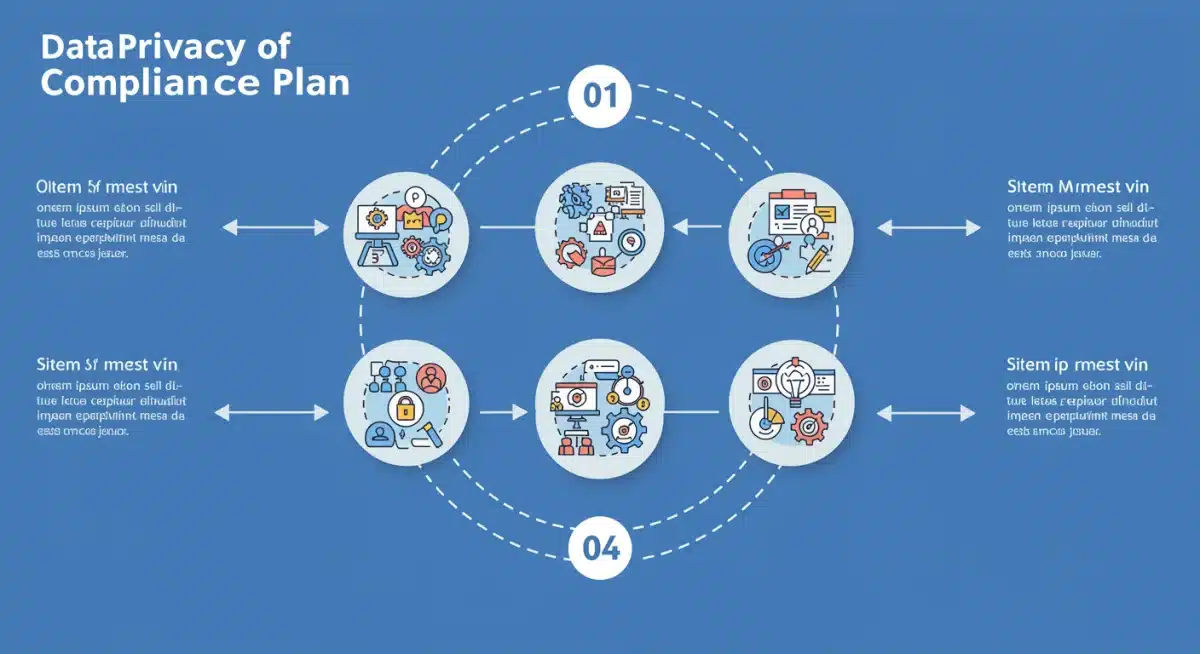Global Data Privacy Framework: 7-Step Plan for US Companies in 2025

US companies must establish a robust global data privacy framework by 2025 to ensure compliance with increasingly stringent international regulations and safeguard consumer data, demanding proactive strategic planning.
As 2025 rapidly approaches, US companies are facing an urgent mandate: establishing a robust and compliant global data privacy framework. The landscape of international data protection is continuously evolving, presenting both significant challenges and crucial opportunities for businesses operating across borders. This comprehensive plan outlines seven practical steps to navigate this complex environment effectively.
Understanding the Evolving Global Privacy Landscape
The global data privacy landscape is undergoing a significant transformation, marked by stricter regulations and heightened enforcement. US companies, particularly those with international operations or customers, must grasp the nuances of these evolving laws to avoid severe penalties and reputational damage. The shift towards comprehensive data protection is a global trend, extending far beyond the European Union’s GDPR.
Recent developments, including new data transfer mechanisms and increased cross-border enforcement collaborations, underscore the immediate need for a harmonized strategy. Businesses can no longer afford a piecemeal approach to data privacy, as interconnected digital ecosystems demand a unified and proactive stance.
Key Regulatory Updates Impacting US Firms
- EU-US Data Privacy Framework (DPF): Operational since July 2023, the DPF provides a mechanism for transatlantic data flows, replacing previous agreements. US companies must self-certify and adhere to strict privacy principles to utilize it.
- Brazil’s LGPD and India’s DPDP Act: These comprehensive laws mirror many GDPR principles, requiring explicit consent, data subject rights, and robust security measures for data processed within or originating from these jurisdictions.
- Expanding US State Laws: Beyond CCPA/CPRA in California, states like Virginia (VCDPA), Colorado (CPA), Utah (UCPA), and Connecticut (CTDPA) have enacted their own privacy laws, creating a complex domestic compliance patchwork that often influences international approaches.
Step 1: Conduct a Comprehensive Data Inventory and Mapping
The foundational step in building a compliant global data privacy framework is understanding what data your company collects, where it resides, and how it flows. This involves a meticulous inventory and mapping exercise, providing a clear picture of your data ecosystem. Without this fundamental understanding, any subsequent compliance efforts will be built on an unstable foundation.
This process should identify all types of personal data, including sensitive categories, and pinpoint their origin, storage locations (both physical and cloud-based), processing activities, and recipients. It’s an ongoing effort, not a one-time task, reflecting the dynamic nature of business operations and data flows.
Identifying Data Sources and Categories
Begin by documenting every system, application, and process that collects, stores, or transmits personal data. This includes customer relationship management (CRM) systems, marketing platforms, HR databases, and even internal spreadsheets. Categorize the data collected, distinguishing between customer data, employee data, vendor data, and website visitor data. Further classify data by sensitivity, noting any special categories requiring enhanced protection under specific regulations.
Step 2: Establish a Robust Legal Basis for Data Processing
For every data processing activity, a clear and valid legal basis must be established, particularly under regulations like GDPR and LGPD. This step is critical for a lawful global data privacy framework, ensuring that data is processed ethically and legally. Relying on vague justifications or generic consent forms is no longer sufficient and can lead to significant regulatory scrutiny.
Companies must meticulously document the legal basis for each processing operation, whether it’s explicit consent, contractual necessity, legitimate interests, legal obligation, or vital interests. This documentation serves as a critical defense in the event of an audit or data subject request.
Consent Management and Legitimate Interests
When relying on consent, ensure it is freely given, specific, informed, and unambiguous. This often requires granular consent mechanisms, allowing individuals to opt-in to specific processing activities. For legitimate interests, conduct a thorough balancing test, weighing the company’s interests against the individual’s rights and freedoms. This test must be documented and regularly reviewed to ensure its continued validity.
Step 3: Implement Comprehensive Data Subject Rights Mechanisms
Modern data privacy regulations empower individuals with significant rights over their personal data. A compliant global data privacy framework must include robust mechanisms to facilitate these rights, such as the right to access, rectification, erasure (‘right to be forgotten’), data portability, and objection to processing. Failing to honor these rights can result in substantial fines and damage to consumer trust.
Establishing clear, efficient processes for handling data subject access requests (DSARs) is paramount. This involves not only technical capabilities to locate and retrieve data but also clear internal policies and trained personnel to respond within mandated timeframes, typically 30 days.
Automating DSAR Responses


Consider investing in specialized software solutions that can automate parts of the DSAR response process. These tools can help identify relevant data across disparate systems, redact sensitive information belonging to other individuals, and securely deliver the requested data to the data subject. Automation reduces the risk of human error and significantly improves response times, crucial for maintaining compliance.
Step 4: Strengthen Data Security and Breach Response Protocols
Data security is the cornerstone of any effective global data privacy framework. While privacy dictates how data is used, security protects it from unauthorized access, loss, or disclosure. US companies must implement state-of-the-art technical and organizational measures to safeguard personal data throughout its lifecycle. This includes encryption, access controls, regular security audits, and employee training.
Equally important are robust data breach response protocols. Regulators worldwide require prompt notification of data breaches to affected individuals and supervisory authorities. A well-defined incident response plan minimizes damage, ensures compliance with notification requirements, and helps maintain public trust.
Key Security Measures to Prioritize
- Encryption: Encrypt data both in transit and at rest, especially for sensitive personal information.
- Access Controls: Implement least privilege access, ensuring employees only access data strictly necessary for their roles.
- Regular Audits: Conduct frequent penetration testing and vulnerability assessments to identify and remediate security weaknesses.
- Employee Training: Regularly train all employees on data security best practices and their role in preventing breaches.
Step 5: Navigate International Data Transfers Compliantly
Transferring personal data across borders is perhaps one of the most complex aspects of building a global data privacy framework. US companies frequently engage in such transfers, whether sending data to cloud providers, international affiliates, or third-party processors. Each transfer must be justified by an appropriate legal mechanism to ensure the data retains adequate protection in its destination.
The EU-US Data Privacy Framework (DPF) is a primary mechanism for transfers from the EU to certified US companies. However, for other regions or non-certified entities, companies must rely on other tools like Standard Contractual Clauses (SCCs) or Binding Corporate Rules (BCRs), often requiring additional due diligence, known as Transfer Impact Assessments (TIAs).
Understanding SCCs and TIAs
Standard Contractual Clauses are pre-approved contractual clauses by the European Commission designed to ensure adequate data protection when data leaves the EU/EEA. When using SCCs, companies must also conduct a Transfer Impact Assessment to evaluate the legal framework of the recipient country and ensure it does not undermine the protections offered by the SCCs. This assessment addresses potential government access to data and other local laws that might impact data privacy.
Step 6: Integrate Privacy by Design and Default Principles
Proactive privacy integration is a hallmark of an advanced global data privacy framework. Privacy by Design (PbD) and Privacy by Default (PbD) are principles that advocate for embedding data protection considerations into the design and operation of all systems, services, products, and business practices from the outset, rather than as an afterthought. This approach minimizes privacy risks and fosters greater trust with consumers.
Privacy by Design means building privacy into the architecture of IT systems and business practices. Privacy by Default means that, by default, personal data should be processed with the highest level of privacy protection, meaning only the necessary data is collected and processed for the specific purpose, and it is retained for the shortest possible period.
Applying PbD in Practice
When developing new products or services, conduct Data Protection Impact Assessments (DPIAs) to identify and mitigate privacy risks early. Ensure that privacy settings are set to the most privacy-friendly option by default, requiring users to actively opt-in to less private settings. This approach not only meets regulatory requirements but also enhances user experience and strengthens brand reputation.
Step 7: Foster a Culture of Continuous Compliance and Accountability
The final, yet ongoing, step in building a sustainable global data privacy framework is to cultivate a culture of continuous compliance and accountability throughout the organization. Data privacy is not a one-time project but an ongoing commitment that requires vigilance, regular training, and clear lines of responsibility. Without a strong internal culture, even the best-laid plans can falter.
This involves appointing dedicated privacy personnel, such as a Data Protection Officer (DPO) where required, establishing clear internal policies and procedures, and conducting regular audits and reviews to ensure adherence to both internal standards and external regulations. Accountability must be embedded at every level, from top management to frontline employees.
Regular Training and Auditing
- Mandatory Training: Implement mandatory, regular privacy awareness training for all employees, tailored to their roles and responsibilities.
- Internal Audits: Conduct periodic internal audits of data processing activities, security measures, and compliance with policies.
- External Reviews: Engage independent third parties for external audits or certifications to demonstrate robust compliance efforts.
- Policy Updates: Regularly review and update privacy policies, terms of service, and internal procedures to reflect changes in laws and business practices.
| Key Aspect | Brief Description |
|---|---|
| Data Inventory | Understand what data is collected, where it’s stored, and how it flows across the organization. |
| Legal Basis | Establish clear legal justifications for every data processing activity, ensuring compliance. |
| Security & Breach Plan | Implement robust security measures and a swift, compliant data breach response protocol. |
| Continuous Compliance | Foster a culture of ongoing vigilance, training, and regular audits to maintain compliance. |
Frequently Asked Questions About Data Privacy Compliance
A global data privacy framework is crucial because international regulations are becoming stricter and more interconnected. Non-compliance can lead to severe financial penalties, reputational damage, and loss of customer trust, making a proactive strategy essential for businesses operating globally.
The EU-US Data Privacy Framework is a mechanism facilitating transatlantic data transfers between the EU and certified US companies. It provides a legal basis for these transfers, ensuring adequate data protection standards are upheld in the United States for European personal data.
US state privacy laws like CCPA/CPRA establish domestic precedents and often influence international approaches to data protection. Companies must integrate these state-level requirements into their broader global framework to ensure comprehensive and consistent compliance across all operational jurisdictions.
DSARs are requests from individuals to access, rectify, or erase their personal data held by an organization. They are important because they represent a fundamental right under many privacy laws, and companies must have efficient processes to respond within specified timeframes to remain compliant.
Privacy by Design means embedding data protection into the core of new systems, products, and processes from their inception. Practically, this involves conducting Data Protection Impact Assessments, minimizing data collection, and setting privacy-friendly defaults, thereby preventing privacy issues before they arise.
What Happens Next
The imperative for US companies to solidify their global data privacy framework by 2025 is immediate and undeniable. As regulatory bodies worldwide continue to strengthen enforcement and introduce new mandates, businesses must view data privacy not as a burden, but as a strategic asset. The coming months will likely see further harmonization efforts between jurisdictions, alongside an increased focus on AI ethics and data governance. Companies that proactively implement these seven steps will be better positioned to navigate the evolving landscape, build consumer trust, and sustain growth in an increasingly data-conscious global economy. Expect continuous updates to international data transfer agreements and amplified scrutiny on data processing practices.





